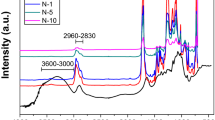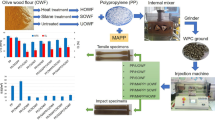Abstract
Mechanical properties such as tensile modulus and strength, elongation-at-break, and impact strength of poly(lactic acid)/ethylene-co-vinyl acetate copolymer (EVA, vinyl acetate content 18 weight %)/Teak wood flour (TWF) composites were evaluated at TWF volume fractions ranging from Φf = 0.1–0.32. Tensile modulus showed an initial increase up to Φf = 0.25 and the parameter decreased marginally at Φf = 0.32, however, remaining much higher than that at Φf = 0. The increase in modulus was attributed to the generation of mechanical restrains by TWF. This mechanical restrains decreased ductility of the composites which also decreased the impact strength. The composite structure was evaluated by comparing the tensile properties with predictive theories, of two-phase models. TWF decreased the thermal stability of the composite, although char yield enhanced due to decomposition of cellulosic bodies in TWF. Differential scanning calorimetry (DSC) studies indicated decrease in the crystallinity of the crystallizable component PLA in the presence of TWF particles in the polymer blend matrix. The biodegradation studies were undertaken to evaluate the biodegradation of the composite under soil burier condition.













Similar content being viewed by others
References
Mohanty AK, Misra M, Drzal LT (2002) Sustainable bio-composites from renewable resources: opportunities and challenges in the green materials world. J Polym Environ 10:19–26. https://doi.org/10.1023/A:1021013921916
Wool RP, Sun XS (2005) Bio-Based Polymers and Composites, Chapter 4. Elsevier Academic Press, United States, p 57
Yu L, Dean K, Li L (2006) Polymer blends and composites from renewable resources. Prog Polym Sci 31:576–602. https://doi.org/10.1016/j.progpolymsci.2006.03.002
Polymers C, Av L (2017) Properties of biocomposites based on lignocellulosic fillers. Carbohydr Polym. https://doi.org/10.1016/j.carbpol.2006.04.004
Kim K, Lee B, Kim H, Dorgan JR, Read M (2012) Thermal and mechanical properties of cassava and pineapple flours-filled PLA bio-composites. J Therm Anal Calorim 108:10–11. https://doi.org/10.1007/s10973-011-1350-y
Oliveira RVB, Schmidt V (2017) Soy protein isolate/poly (lactic acid) injection- molded biodegradable blends for slow release of fertilizers. Ind Crops Prod 36:41–46. https://doi.org/10.1016/j.indcrop.2011.08.003
Yew GH, Mohd Yusof AM, Mohd Ishak ZA, Ishiaku US (2005) Water absorption and enzymatic degradation of poly(lactic acid)/rice starch composites. Polym Degrad Stab 90:488–500. https://doi.org/10.1016/j.polymdegradstab.2005.04.006
Oksman K, Skrifvars M, Selin J (2003) Natural fibres as reinforcement in polylactic acid (PLA) composites natural fibres as reinforcement in polylactic acid (PLA) composites. Compos Sci Technol 63:1317–1324. https://doi.org/10.1016/s0266-3538(03)00103-9
Shanks RA, Hodzic A, Ridderhof D (2005) Composites of poly (lactic acid) with flax fibers modified by interstitial polymerization. J Appl Polym Sci 99:2305–2313. https://doi.org/10.1002/app.22531
Plackett D, Løgstrup T, Batsberg W, Nielsen L (2003) Biodegradable composites based on l -polylactide and jute fibres. Composites Sci Technol 63:1287–1296. https://doi.org/10.1016/S0266-3538(03)00100-3
Serizawa S, Inoue K, Iji M (2005) Kenaf-Fiber-reinforced poly (lactic acid) used for electronic products. J Appl Polym Sci. 100:618–624. https://doi.org/10.1002/app.23377
Shibata M, Ozawa K, Teramoto N, Yosomiya R, Takeishi H (2003) Biocomposites made from short abaca fiber and biodegradable polyesters. Macromol Mater Eng 288:35–43. https://doi.org/10.1002/mame.200290031
Lee S, Wang S (2006) Biodegradable polymers/bamboo fiber biocomposite with bio-based coupling agent. Composites Part A Appl Sci Manuf 37:80–91. https://doi.org/10.1016/j.compositesa.2005.04.015
Polylactide WR (2006) Dynamic-mechanical properties of wood-fiber reinforced polylactide: experimental characterization and micromechanical modeling. J Thermoplast Composite Mater 19:613–637. https://doi.org/10.1177/089270570606748
Yu L, Petinakis S, Dean K, Bilyk A, Wu D (2007) Green polymeric blends and composites from renewable resources. Macromol Symp 249–250:535–539. https://doi.org/10.1002/masy.200750432
Park JW, Im SS (2003) Miscibility and morphology in blends of poly (L -lactic acid) and poly (vinyl acetate- co -vinyl alcohol). Polymer 44:4341–4354. https://doi.org/10.1016/s0032-3861(03)00346-x
Gajria AM, Mccarthy SP (1996) Miscibility poly (lactic and biodegradability acid) and poly (vinyl of blends acetate). Polymer 37:437–444. https://doi.org/10.1016/0032-3861(96)82913-2
Zhang X, Xiao Y, Lang M (2012) Synthesis and degradation behavior of miktoarm poly (e -caprolactone) 2-b-poly (L -lactone) 2 microspheres. Polym J 45:420–426. https://doi.org/10.1038/pj.2012.166
Nehra R (2018). Ph.D. thesis: studies on polylactide-based blend and nanocomposites. IIT Delhi
Su Z, Li Q, Liu Y, Hu G, Wu C (2009) Compatibility and phase structure of binary blends of poly (lactic acid) and glycidyl methacrylate grafted poly (ethylene octane). Eur Polym J 45:2428–2433. https://doi.org/10.1016/j.eurpolymj.2009.04.028
Jaratrotkamjorn R, Khaokong C, Tanrattanakul V (2011) Toughness enhancement of poly (lactic acid) by melt blending with natural rubber. J Appl Polym Sci. https://doi.org/10.1002/app
Park JW, Im SS (2002) Phase behavior and morphology in blends of poly (L-lactic acid) and poly (butylene succinate). J Appl Polym Sci 86:647–655. https://doi.org/10.1002/app.10923
Abddwahab MA, Flynn A, Chiou BS, Immam S, Orls W, Chizellini E (2012) Polym Degrad stab. 97(9): 1822–1828. https://doi.org/10.1016/j.polymdegradstab.2012.05.036
Singla RK, Maiti SN, Ghosh AK (2016) RSC Advances ethylene- co -vinyl-acetate blends via a melt mechanical and morphological interpretation. RSC Adv 6:14580–14588. https://doi.org/10.1039/c5ra24897c
Ja O et al (2011) Composites: part A nanocomposite nanofibers of poly (d, l -lactic-co-glycolic acid) and graphene oxide nanosheets. Compos A 42:1978–1984
Sharma R, Maiti SN (2014) Effects of crystallinity of PP and flexibility of SEBS-g-MA copolymer on the mechanical properties of PP/SEBS-g-MA blends. Polym Plast Technol Eng 53:229–238. https://doi.org/10.1080/03602559.2013.843706
Sewda K, Maiti SN (2009) Mechanical properties of teak wood flour-reinforced HDPE composites. J Appl Polym Sci. https://doi.org/10.1002/app
ASTM D 256-10E1 (2014) Standard test method for determining the Izod pendulum impact resistance of plastics. ASTM international, west conshohocken, PA, 2010. ASTM D 368-14, PA, 2014
Li Y et al (2011) Mechanical properties of poly (l -lactide)/ethylene- co -vinyl acetate blends with different VA contents. Prog Polym Sci 32(4):483–507. https://doi.org/10.1002/app
Kumar R, Yakubu MK, Anandjiwala RD (2010) Biodegradation of flax fiber reinforced poly lactic acid. Expr Polym Lett 4:423–430. https://doi.org/10.3144/expresspolymlett.2010.53
Yussuf AA, Massoumi I, Hassan A (2010) Comparison of polylactic acid/kenaf and polylactic acid/rise husk composites: the influence of the natural fibers on the mechanical, thermal and biodegradability properties. J Polym Environ 18:422–429. https://doi.org/10.1007/s10924-010-0185-0
Singhla RK, Maiti SN, Ghosh AK (2016) Mechanical, morphological, and solid- state viscoelastic response of poly(lactic acid)/ethylene-co-vinyl-acetate super-tough blend reinforced with halloysite nanotubes. J Mater Sci 51:10278–10292. https://doi.org/10.1007/s1083-016-0255-3
Li Y, Venkateshan K, Sun XS (2010) Mechanical and thermal properties, morphology and relaxation characteristics of poly(lactic acid) and soy flour/wood flour blends. Polym Int 59:1099–1109. https://doi.org/10.1002/pi.2834
Sun XS, Moura RA, Li W (2017) Effects of starch types on mechanical properties of poly (lactic acid)/starch composites. Int Polym Proc 22:3139. https://doi.org/10.3139/217.2052
Brebu M, Vasile C (2010) Thermal degradation of lignin—a review. Cellul Chem Technol. 44:353–363.
Gordobil O, Egüés I, Llano-Ponte R, Labidi J (2014) Physicochemical properties of PLA lignin blends. Polym Degrad Stab 108:330–338. https://doi.org/10.1016/j.polymdegradstab.2014.01.002
Dorez G, Ferry L, Sonnier R, Taguet A, Lopez-Cuesta JM (2014) Effect of cellulose, hemicellulose and lignin contents on pyrolysis and combustion of natural fibers. J Anal Appl Pyrol 107:323–331. https://doi.org/10.1016/j.jaap.2014.03.017
Li J, He Y, Inoue Y (2003) Thermal and mechanical properties of biodegradable blends of poly (l -lactic acid) and lignin. Polym Int 955:949–955. https://doi.org/10.1002/pi.1137
Jaggi HS, Kumar Y, Satapathy BK, Ray AR, Patnaik A (2012) Analytical interpretations of structural and mechanical response of high density polyethylene/hydroxyapatite bio-composites. Mater Des 36:757–766. https://doi.org/10.1016/j.matdes.2011.12.004
Sharma R, Maiti SN (2013) Modification of tensile and impact properties of poly (butylene terephthalate) by incorporation of styrene-ethylene-butylene-styrene and maleic anhydride- grafted -SEBS (SEBS- g -MA) terpolymer. Polym Eng Sci 53(10):2242–2253. https://doi.org/10.1002/pen
Sewda K, Maiti SN (2007) Mechanical properties of HDPE/Bark flour composites. J Appl Polym Sci 105:2598–2604. https://doi.org/10.1002/app.26293
Nielsen LE, Nielsen LE (2017) Mechanical properties of particulate-filled systems. J Compos Mater 16:1–6. https://doi.org/10.1177/002199836700100110
Zhu W, Huang Y, Jun H, Shan D (2012) Preparation and properties of poly (lactic acid)/cellulolytic enzyme lignin/PGMA ternary blends. Chin Chem Lett 23:351–354
Gandhi A, Bhatnagar N (2015) Physical blowing agent residence conditions stimulated morphological transformations in extrusion foaming physical blowing agent residence conditions stimulated Abhishek Gandhi and Naresh Bhatnagar. LPTE 54:1812–1818. https://doi.org/10.1080/03602559.2015.1050518
Wang D (2011) Poly (Lactic Acid) blended with cellulolytic enzyme lignin: mechanical and thermal properties and morphology evaluation poly (Lactic Acid) blended with cellulolytic enzyme lignin: mechanical and thermal properties and morphology Evaluation. J Polym Environ. https://doi.org/10.1007/s10924-011-0359-4
Galeski Z, Kowalczuk A, Sobota M, Malinowski M (2017) Tough blends of poly (lactide) and amorphous poly ([R, S] -3-hydroxy butyrate)—morphology and properties. Eur Polym J 49(11):3630–3641
Kowalczyk M, Piorkowska E, Dutkiewicz S, Sowinski P (2014) Toughening of polylactide by blending with a novel random aliphatic-aromatic copolyester. Eur Polym J 59:59–68. https://doi.org/10.1016/j.eurpolymj.2014.07.002
Evstatiev M, Simeonova S, Friedrich K, Formanek P (2013) MFC-structured biodegradable poly (l-lactide)/poly (butylene adipate-co-terephatalate) blends with improved mechanical and barrier properties. J Mater Sci 48:6312–6330. https://doi.org/10.1007/s10853-013-7431-5
Ochi S (2008) Mechanical properties of kenaf fibers and kenaf/PLA composites. Mech Mater 40:446–452. https://doi.org/10.1016/j.mechmat.2007.10.006
Ohkita T, Lee S (2005) Thermal degradation and biodegradability of poly(lactic acid)/corn starch biocomposites. J Appl Polym Sci 100:3009–3017. https://doi.org/10.1002/app.23425
Author information
Authors and Affiliations
Corresponding author
Supporting information
Supporting information
The DTG curves of PLA/EVA/TWF composites are shown in Fig. 14 which shows double peaks.
Rights and permissions
About this article
Cite this article
Mullapudi, S.S., Pandey, K., Maiti, S.N. et al. PLA/EVA/Teak Wood Flour Biocomposites for Packaging Application: Evaluation of Mechanical Performance and Biodegradation Properties. J Package Technol Res 2, 191–201 (2018). https://doi.org/10.1007/s41783-018-0037-2
Received:
Accepted:
Published:
Issue Date:
DOI: https://doi.org/10.1007/s41783-018-0037-2





